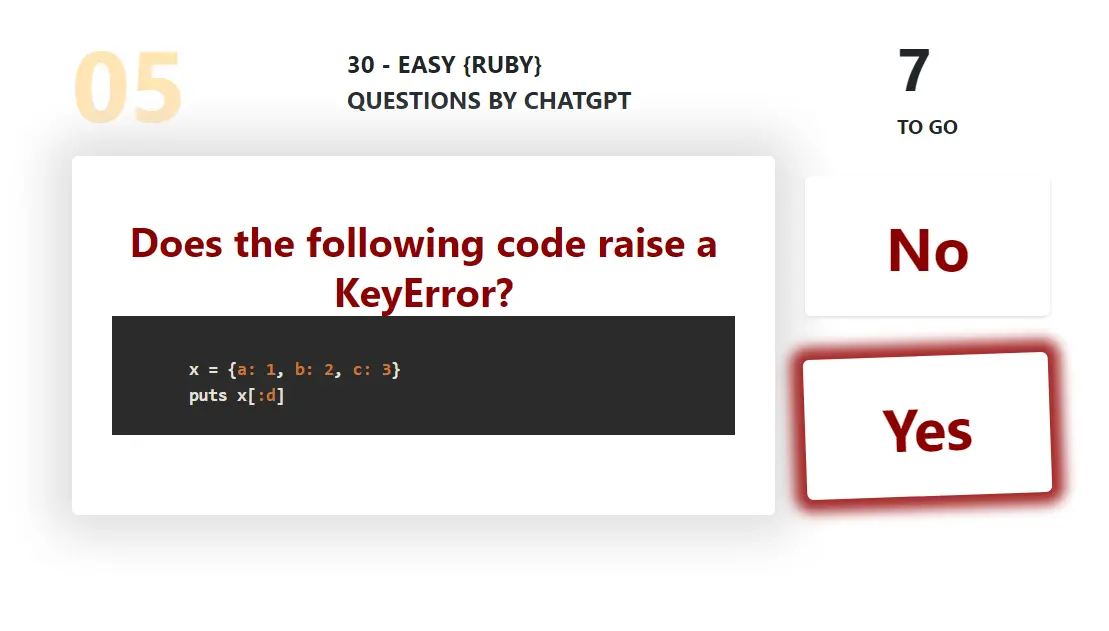
Ruby Programming Language and Its Most Used Set of Algorithms 30/03/2023 ~ Views: 1310
Ruby is a popular object-oriented programming language known for its simplicity, expressiveness, and flexibility. It was created in the mid-1990s by Yukihiro "Matz" Matsumoto and has since gained popularity among developers for its ease of use and readability. In this post, we will take a look at some of the most commonly used algorithms in Ruby, along with code examples for each.
Sorting Algorithms
Sorting algorithms are used to arrange a list of elements in a specific order, such as ascending or descending. The following are some of the most commonly used sorting algorithms in Ruby:
Bubble Sort
Bubble sort is one of the simplest sorting algorithms and works by repeatedly swapping adjacent elements if they are in the wrong order. Here's an implementation of bubble sort in Ruby:
def bubble_sort(array)
n = array.length
loop do
swapped = false
(n-1).times do |i|
if array[i] > array[i+1]
array[i], array[i+1] = array[i+1], array[i]
swapped = true
end
end
break if not swapped
end
array
end
arr = [3, 5, 2, 1, 4]
p bubble_sort(arr)Insertion Sort
Insertion sort works by building a final sorted array one element at a time, by comparing each new element with the already sorted elements and inserting it at the correct position. Here's an implementation of insertion sort in Ruby:
def insertion_sort(array)
for i in 1...(array.length)
key = array[i]
j = i - 1
while j >= 0 and array[j] > key
array[j+1] = array[j]
j -= 1
end
array[j+1] = key
end
array
end
arr = [3, 5, 2, 1, 4]
p insertion_sort(arr)Selection Sort
Selection sort works by repeatedly finding the minimum element from the unsorted part of the array and putting it at the beginning. Here's an implementation of selection sort in Ruby:
def selection_sort(array)
n = array.length
for i in 0...(n-1)
min_index = i
for j in (i+1)...n
if array[j] < array[min_index]
min_index = j
end
end
array[i], array[min_index] = array[min_index], array[i]
end
array
end
arr = [3, 5, 2, 1, 4]
p selection_sort(arr)Quick Sort
Quick sort is a divide-and-conquer sorting algorithm that works by selecting a 'pivot' element and partitioning the array around the pivot, recursively sorting the left and right subarrays. Here's an implementation of quick sort in Ruby:
def quick_sort(array)
return array if array.length <= 1
pivot = array.delete_at(rand(array.length))
left, right = array.partition { |num| num < pivot }
return *quick_sort(left), pivot, *quick_sort(right)
end
arr = [3, 5, 2, 1, 4]
p quick_sort(arr)Merge Sort
Merge sort is another divide-and-conquer algorithm that works by recursively dividing the array into halves, sorting them, and then merging them. Here's an implementation of merge sort in Ruby:
def merge_sort(array)
return array if array.length <= 1
mid = array.length / 2
left = array[0...mid]
right = array[mid..-1]
merge(merge_sort(left), merge_sort(right))
end
def merge(left, right)
sorted = []
until left.empty? || right.empty?
if left.first <= right.first
sorted << left.shift
else
sorted << right.shift
end
end
sorted.concat(left).concat(right)
end
arr = [3, 5, 2, 1, 4]
p merge_sort(arr)Searching Algorithms
Searching algorithms are used to find the position or occurrence of a specific element in a list. The following are some of the most commonly used searching algorithms in Ruby:
Linear Search
Linear search is the simplest search algorithm that works by iterating through each element in the list until the target element is found. Here's an implementation of linear search in Ruby:
def linear_search(array, target)
array.each_with_index do |element, index|
return index if element == target
end
nil
end
arr = [1, 2, 3, 4, 5]
p linear_search(arr, 3)Binary Search
Binary search is a more efficient search algorithm that works by dividing the list in half at each step and eliminating half of the remaining elements until the target element is found. Here's an implementation of binary search in Ruby:
def binary_search(array, target)
low = 0
high = array.length - 1
while low <= high
mid = (low + high) / 2
if array[mid] == target
return mid
elsif array[mid] < target
low = mid + 1
else
high = mid - 1
end
end
nil
end
arr = [1, 2, 3, 4, 5]
p binary_search(arr, 3)Graph Algorithms
Breadth-First Search (BFS)
Breadth-first search is a graph traversal algorithm that visits all the vertices of a graph in breadth-first order, i.e., it visits all the vertices at the same level before moving to the next level. Here's an implementation of BFS in Ruby:
def bfs(graph, start)
queue = [start]
visited = []
until queue.empty?
vertex = queue.shift
next if visited.include?(vertex)
visited << vertex
queue.concat(graph[vertex])
end
visited
end
graph = {
'A' => ['B', 'C'],
'B' => ['A', 'D', 'E'],
'C' => ['A', 'F'],
'D' => ['B'],
'E' => ['B', 'F'],
'F' => ['C', 'E']
}
p bfs(graph, 'A')Depth-First Search (DFS)
Depth-first search is a graph traversal algorithm that visits all the vertices of a graph in depth-first order, i.e., it visits all the vertices in a branch before moving to the next branch. Here's an implementation of DFS in Ruby:
def dfs(graph, start)
stack = [start]
visited = []
until stack.empty?
vertex = stack.pop
next if visited.include?(vertex)
visited << vertex
stack.concat(graph[vertex])
end
visited
end
graph = {
'A' => ['B', 'C'],
'B' => ['A', 'D', 'E'],
'C' => ['A', 'F'],
'D' => ['B'],
'E' => ['B', 'F'],
'F' => ['C', 'E']
}
p dfs(graph, 'A')Dijkstra's Algorithm
Dijkstra's algorithm is a shortest path algorithm that finds the shortest path from a source vertex to all other vertices in a weighted graph. Here's an implementation of Dijkstra's algorithm in Ruby:
def dijkstra(graph, source)
distances = {}
previous = {}
unvisited = graph.keys
graph.each do |vertex, edges|
distances[vertex] = Float::INFINITY
previous[vertex] = nil
end
distances[source] = 0
until unvisited.empty?
current = unvisited.min_by { |vertex| distances[vertex] }
unvisited.delete(current)
graph[current].each do |neighbor, weight|
alt = distances[current] + weight
if alt < distances[neighbor]
distances[neighbor] = alt
previous[neighbor] = current
end
end
end
[distances, previous]
end
graph = {
'A' => { 'B' => 5, 'C' => 10 },
'B' => { 'D' => 7, 'E' => 2 },
'C' => { 'F' => 5 },
'D' => { 'E' => 1 },
'E' => { 'F' => 3 },
'F' => {}
}
distances, previous = dijkstra(graph, 'A')
p distances
p previousString Manipulation Algorithms
Reverse a String
Reversing a string involves reversing the order of characters in the string. Here's an implementation of string reversal in Ruby:
def reverse_string(string) string.reverse end
Palindrome Detection
A palindrome is a word, phrase, number, or other sequence of characters that reads the same forward and backward. Here's an implementation of palindrome detection in Ruby:
def palindrome?(string) string == string.reverse end
String Permutations
A string permutation is any possible rearrangement of the characters in a string. Here's an implementation of string permutation generation in Ruby:
def string_permutations(string)
return [string] if string.size == 1
result = []
string.chars.each_with_index do |char, index|
remaining = string[0...index] + string[index+1..-1]
string_permutations(remaining).each do |perm|
result << char + perm
end
end
result
end
p string_permutations("abc")Longest Common Substring
A common substring of two strings is a substring that appears in both strings. The longest common substring is the longest substring that appears in both strings. Here's an implementation of longest common substring finding in Ruby:
def longest_common_substring(str1, str2)
m = str1.length
n = str2.length
l = Array.new(m+1) { Array.new(n+1, 0) }
result = ""
(0..m).each do |i|
(0..n).each do |j|
if i == 0 || j == 0
l[i][j] = 0
elsif str1[i-1] == str2[j-1]
l[i][j] = l[i-1][j-1] + 1
result = str1[i-l[i][j]..i-1] if l[i][j] > result.length
else
l[i][j] = 0
end
end
end
result
end
p longest_common_substring("abcdef", "abcde")These are just a few examples of the many algorithms and techniques available in Ruby for sort, search, graph traversal and string manipulation. With the power of Ruby's concise syntax and built-in data structures, these algorithms can be implemented with ease, making Ruby a popular choice among developers for a wide range of applications.
Tags: #ruby #programminglanguage #algorithms #graph #chatgpt #stringmanipulation #depthfirstsearch #dijkstrasalgorithm #sortalgorithms #searchalgorithms








